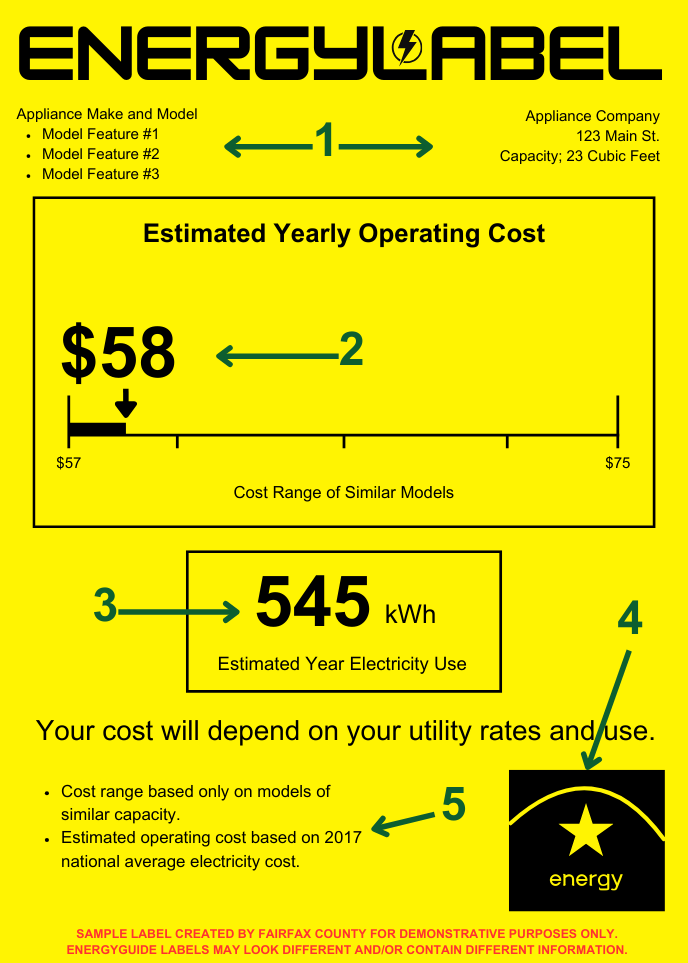Post written by Maggie Beetstra, Community Specialist
Fairfax County celebrates Energy Efficiency Day on October 2, a national day of awareness and action around conserving energy to lower costs and improve the health of communities. In honor of Energy Efficiency Day, we want to provide this resource on how to purchase the most energy-efficient appliances and windows for your home.
Making a large purchase like getting a new appliance, television, or windows requires doing some research ahead of time. You might consider online reviews, recommendations from people you know, and price before making your choice. There is another piece of information you might want to add to the mix too: energy efficiency. More energy-efficient appliances use less electricity or natural gas to run them, while energy-efficient windows reduce energy use by heating and cooling systems. Higher energy efficiency translates to fewer carbon emissions produced if your energy comes from non-renewable sources. Plus, you'll benefit even more by saving on your energy bills.
But where can you find energy efficiency information? For many purchases, it is easier to find than you might expect. Most appliances and televisions have a bright yellow sticker on the front, while new windows often have a while label on them. These are examples of energy efficiency labels, and they include lots of relevant information to help consumers make informed purchases.
Reading the Yellow Tag
Let’s review some of the common pieces of information on these labels.
The yellow stickers on appliances and televisions contain consistent information that makes it easy for consumers to compare across products.

Important information found on the yellow label:
- Information about the type of product you are purchasing and its make and model.
- The estimated yearly energy cost compared to other similar models. For example, if you purchase a refrigerator, the estimated yearly energy cost would be in comparison to other similar refrigerators currently on the market.
- The estimated amount of electricity the appliance will use. The number is in the units of kilowatt-hours (kWh), a common unit of electricity consumption. To get a more specific estimate for your home, look at your most recent electricity bill to see what your utility provider charges per kWh in your area and then multiply by the number in this box.
- The ENERGY STAR® logo indicating high energy efficiency. (The sample label above is not an accurate depiction of the ENERGY STAR® logo.) You might also notice the ENERGY STAR® logo on other items in either black, white, or blue. The logo signals to consumers that the product uses less electricity than other similar products so therefore is a more energy efficient choice.
- Additional context for the numbers included on the tag, such as what kind of similar products were used for comparison, the year used as a baseline for electricity costs, and sometimes a link to additional information.
Reading a Window Tag
Energy efficiency labels on windows look slightly different and convey unique, but equally important, information to consumers.

Important information found on the window label:
- The National Fenestration Rating Council® label indicates that the window was independently rated using a standardized procedure. Sometimes, the ENERGY STAR® logo will also appear here when it is a more energy efficient option. (The sample label above is not an accurate depiction of the NFRC logo.)
- The U-Factor measures heat transfer from the glass, frame, and other window fittings into and out of the building. When comparing across windows, a smaller U-Factor is more energy efficient. (Lower = better)
- The Solar Heat Gain Coefficient measures solar energy from the glass, frame, and other window fittings into and out of the building. Like the U-Factor, a smaller value is more energy efficient. (Lower = better)
- The Visible Transmittance measures the amount of visible light entering a building through the window. The value can range from 0-1, with 0 meaning that all visible light is blocked and 1 that no visible light is blocked. The optimal value will depend on the climate of your area and your specific lighting needs but in general, higher values reduce the need for indoor electric lighting and can provide some small warming benefits in colder months. (Higher = better)
- The Air Leakage value indicates how much air seeps into a building through the window when it is closed. A lower number means that the window is more energy efficient. (Lower = better)
The next time you make a big purchase, look for these labels and shop with confidence knowing that you are making an energy efficient choice.
Check out our Home Energy webpage to learn more about making smart choices about home energy use and to find federal, state, and energy provider incentives that can help Fairfax County residents offset the costs of purchasing and installing energy-efficiency upgrades and equipment.

Maggie Beetstra joined OEEC in summer 2024 as a community specialist staffing the county’s Environmental Quality Advisory Council (EQAC). She also assists with the implementation of the Community-Wide Energy and Climate Action Plan through the development of a residential energy program. Maggie holds degrees from Washington University in St. Louis, the University of Washington, and The Ohio State University.
Climate Matters is the blog of Fairfax County’s Office of Environmental and Energy Coordination, where we share stories, insights and information related to climate change and environmental sustainability. Posts are written by knowledgeable and passionate OEEC staff members and guest authors. To read all blog posts, visit Climate Matters.

